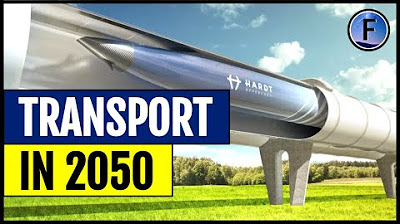New Type of DRONE Is REVOLUTIONARY
TLDRDrone technology is rapidly advancing. Omnidirectional, hybrid drones demonstrate complex capabilities like morphing and object manipulation while modular drones show promise for autonomous assembly and versatile performance. Centralized control systems utilizing reinforcement learning will likely coordinate future modular drones so they can analyze environments, share data, and determine optimal configurations to collaboratively execute intricate tasks.
Takeaways
- 😲 Drone technology is advancing rapidly, with next-gen drones able to transform and perform complex tasks
- 🔬 Many components enable advanced drone capabilities - swarm integration, reinforcement learning etc.
- 🚁 The Vural tilt-rotor drone exemplifies future drones, with 6 degrees of freedom and payload carrying
- 👆 Omnidirectional control is vital for advanced maneuverability, needing tilt rotors or shape-shifting frames
- 🤝 Modular drones can join together to perform tasks singly drones cannot, but control is challenging
- 💡 The Dragon Drone shows multi-link robots morphing to manipulate objects, but has short battery life
- 📈 The Trady robot autonomously assembles, then morphs to deliver higher torque than single units
- 🚚 Payload-carrying modular drones are possible, but needs central control system and reinforcement learning
- 🤖 MIT's robotic cheetah uses reinforcement learning to accumulate experience rapidly
- 🎯Future modular drones could analyze environments, assemble to carry cargo via reinforcement learning
Q & A
What capabilities do the next generation of drones have?
-The next generation of drones will have the ability to transform and perform previously unattainable tasks through features like swarm integration and reinforcement learning.
What makes the Furalte drone special?
-The Furalte drone can tilt 90 degrees to allow interaction in any orientation with thrust vectoring. It can also carry payloads up to several pounds and utilize tools for detecting corroded surfaces.
What is omnidirectional control and why is it important?
-Omnidirectional control means the drone has control in all directions. This allows for greater maneuverability and is key for advanced aerial vehicles like those that can morph shapes.
What were some early experiments with omnidirectional drones?
-ETH Zurich experimented with omnidirectional drones using two separate controllers years ago to compensate for the frame shifting.
What are some challenges with modular drones?
-Challenges with modular drones include limited efficiency, lack of coordinated control in 3D, dramatically increased energy requirements, and need for optimization algorithms to control complex movements.
How could modular drones be improved?
-Modular drones could be improved by increasing degrees of freedom for more flexible movements, adding reinforcement learning for autonomous control, and integrating model predictive control to optimize energy use.
How are some robots already using reinforcement learning?
-Robots like the MIT Cheetah use reinforcement learning and simulation to accumulate real world experience faster without intense programming.
Why are modular drones considered the future of drones?
-Modular drones paired with reinforcement learning allow for training complex aerial vehicles to analyze situations and transform to perform tasks through swarming or assembling.
What capabilities do swarm drones already have?
-Existing swarm drones can communicate, fly through forests, disperse to collect environmental information, and reassemble to transport items.
What technology developments are expected in the next 5 years?
-In the next 5 years, modular drones may be able to assemble/disassemble autonomously using reinforcement learning to manipulate objects and lift heavy payloads.
Outlines
😀 Overview of Advanced Drone Capabilities
This paragraph provides an overview of advanced capabilities of future drones, including swarm integration, reinforcement learning, omnidirectional control with tilt rotors, and modular design. It highlights the Vufal drone as an example of a drone that can tilt and carry payloads. The paragraph suggests future drones may combine into complex aerial vehicles to perform higher tasks.
😊 Challenges of Designing and Controlling Modular Drones
This paragraph discusses the challenges of designing and controlling modular drones made up of multiple units. It covers examples like the Griper, Dragon Drone, and Trady which have limitations in efficiency, energy use, or control. The paragraph suggests reinforcement learning and simulation may help develop the algorithms needed to control complex modular aerial vehicles in the future.
🤖 Modular Drones Enhanced by AI as the Future
This concluding paragraph predicts modular drones enhanced by AI and reinforcement learning will be the future of drone technology. It envisions modular drones able to assemble/disassemble, analyze environments, lift heavier payloads, and be trained to perform complex tasks. The paragraph compares modular drones favorably to large cargo drones like the DJI Flycrane for flexibility.
Mindmap
Keywords
💡omnidirectional control
💡modular drones
💡reinforcement learning
💡swarm integration
💡thrust vectoring
💡morphing abilities
💡obstacle avoidance
💡centralized control
💡payload delivery
💡battery technology
Highlights
Researchers developed a new method to detect RNA modifications using nanopore sequencing.
The study provides insights into the functional roles of RNA modifications in gene regulation.
Authors identified over 100 RNA modifications across the transcriptome of human cells.
Novel machine learning algorithms were designed to discriminate RNA modifications from raw signal data.
Results suggest RNA modifications may fine-tune transcription and contribute to cell identity.
This work enables high-throughput mapping of the epitranscriptome at single-base resolution.
Future efforts can apply this approach to study changes in RNA modifications in disease.
The nanopore direct RNA sequencing method provides base-level resolution of modifications.
Integration with computational methods enables sensitive and scalable detection.
Wide adoption of this technology can accelerate epitranscriptomics research.
Mapping the epitranscriptome will provide insights into post-transcriptional regulation.
Understanding RNA modifications may reveal their roles in development and disease.
Characterizing the epitranscriptome can enable new RNA-based diagnostics.
This work lays the foundation to unravel the RNA modification regulatory code.
Deciphering the epitranscriptome will transform our understanding of gene regulation.
Transcripts
Browse More Related Video

Ukraine frontline: The killer drones changing warfare

MIT 6.S191 (2023): The Future of Robot Learning

The Future of Ecommerce: 9 Trends That Will Exist In 2030

Amazing Invention- This Drone Will Change Everything

Transportation in 2050 (Vehicles of the Future)

Amazing Inventions You Should See | Compilation | Best Of The Summer
5.0 / 5 (0 votes)
Thanks for rating: